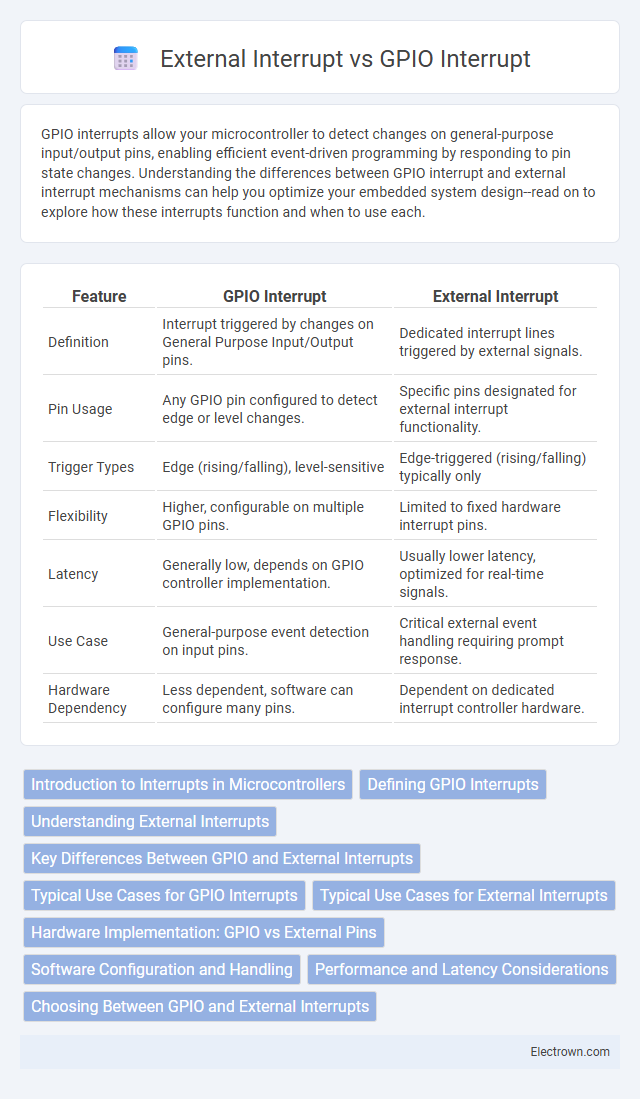GPIO interrupts allow your microcontroller to detect changes on general-purpose input/output pins, enabling efficient event-driven programming by responding to pin state changes. Understanding the differences between GPIO interrupt and external interrupt mechanisms can help you optimize your embedded system design--read on to explore how these interrupts function and when to use each.
Table of Comparison
| Feature | GPIO Interrupt | External Interrupt |
|---|---|---|
| Definition | Interrupt triggered by changes on General Purpose Input/Output pins. | Dedicated interrupt lines triggered by external signals. |
| Pin Usage | Any GPIO pin configured to detect edge or level changes. | Specific pins designated for external interrupt functionality. |
| Trigger Types | Edge (rising/falling), level-sensitive | Edge-triggered (rising/falling) typically only |
| Flexibility | Higher, configurable on multiple GPIO pins. | Limited to fixed hardware interrupt pins. |
| Latency | Generally low, depends on GPIO controller implementation. | Usually lower latency, optimized for real-time signals. |
| Use Case | General-purpose event detection on input pins. | Critical external event handling requiring prompt response. |
| Hardware Dependency | Less dependent, software can configure many pins. | Dependent on dedicated interrupt controller hardware. |
Introduction to Interrupts in Microcontrollers
Interrupts in microcontrollers enable efficient CPU utilization by temporarily halting the main program to address urgent tasks. GPIO interrupts are triggered by changes in the state of specific General Purpose Input/Output pins, ideal for detecting input signals or external events. External interrupts refer to a broader category, often including dedicated hardware lines that monitor more complex external signals, offering precise control for your embedded system's real-time responsiveness.
Defining GPIO Interrupts
GPIO interrupts are specific signals triggered by changes in the state of General Purpose Input/Output pins, enabling real-time response to external events without continuous polling. These interrupts are configured by setting edge detection (rising, falling, or both) on GPIO pins, allowing microcontrollers to efficiently manage asynchronous inputs. Unlike general external interrupts, GPIO interrupts are tightly integrated with the GPIO subsystem, providing fine-grained control over pin-level input events.
Understanding External Interrupts
External interrupts are signals from external devices that trigger immediate processor attention, ensuring timely response to events such as button presses or sensor output. Unlike general GPIO interrupts that may be software-managed or less prioritized, external interrupts typically have dedicated hardware lines for faster and more reliable activation. These interrupts bypass regular polling methods, reducing latency and improving system efficiency in embedded applications.
Key Differences Between GPIO and External Interrupts
GPIO interrupts are triggered by changes on general-purpose input/output pins, allowing for flexible event detection directly from hardware signals. External interrupts, typically managed by dedicated interrupt controllers, are designed for prioritized, low-latency responses to specific external signals or events beyond basic GPIO changes. Key differences include interrupt source specificity, priority handling capabilities, and the scope of hardware integration within microcontroller or processor architectures.
Typical Use Cases for GPIO Interrupts
GPIO interrupts are commonly used in embedded systems for detecting real-time changes on input pins, such as button presses, sensor signals, or rotary encoder movements. These interrupts enable low-latency response by triggering immediate processing when a pin state changes, reducing CPU polling overhead. Typical use cases include user interface controls, event-driven sensor monitoring, and managing asynchronous signals in microcontroller applications.
Typical Use Cases for External Interrupts
External interrupts are commonly used to detect specific events like button presses, sensor signals, or communication pulses that require immediate processor attention. These interrupts enable prompt response to critical external triggers, ensuring your system can handle real-time events efficiently without constant polling. Typical use cases include wake-up signals, alarm systems, and user input detection in embedded applications.
Hardware Implementation: GPIO vs External Pins
GPIO interrupts are triggered by changes in the state of general-purpose input/output pins, which are versatile and configured through software for various input signals, whereas external interrupts rely on dedicated external interrupt pins specifically designed to detect signal changes with higher priority and lower latency. Hardware implementation of GPIO interrupts typically involves flexible multiplexers and interrupt controllers integrated within the microcontroller's GPIO module, providing programmable edge or level detection on multiple pins. External interrupt pins use specialized, often edge-sensitive hardware circuits optimized for rapid, deterministic response, enabling immediate CPU attention and faster interrupt servicing compared to generalized GPIO interrupt handling.
Software Configuration and Handling
GPIO Interrupts typically require configuring individual pins as interrupt sources within the microcontroller's software, enabling edge or level detection modes specific to each pin. External Interrupts usually involve setting up dedicated interrupt lines with predefined priority levels and vector handlers, often requiring global interrupt enable settings in the interrupt controller. Your software must handle the interrupt service routines efficiently to process signals from GPIO or external sources without causing latency or missed events.
Performance and Latency Considerations
GPIO interrupts often provide lower latency because they are directly linked to specific General Purpose Input/Output pins, enabling faster response times for real-time applications. External interrupts, while flexible and capable of handling various signal sources, may introduce slightly higher latency due to additional hardware or software layers required for their processing. Optimizing interrupt priority and minimizing ISR execution time are critical for maximizing performance in both GPIO and external interrupt scenarios.
Choosing Between GPIO and External Interrupts
Choosing between GPIO interrupts and external interrupts depends on your specific application requirements and hardware capabilities. GPIO interrupts offer flexibility by allowing you to configure interrupts on multiple general-purpose pins, ideal for detecting simple input changes, while external interrupts are typically connected to dedicated hardware lines designed for precise timing and higher reliability. Your choice should consider the complexity of the signals, latency needs, and the microcontroller's interrupt handling features for optimal system performance.
GPIO Interrupt vs External Interrupt Infographic

 electrown.com
electrown.com